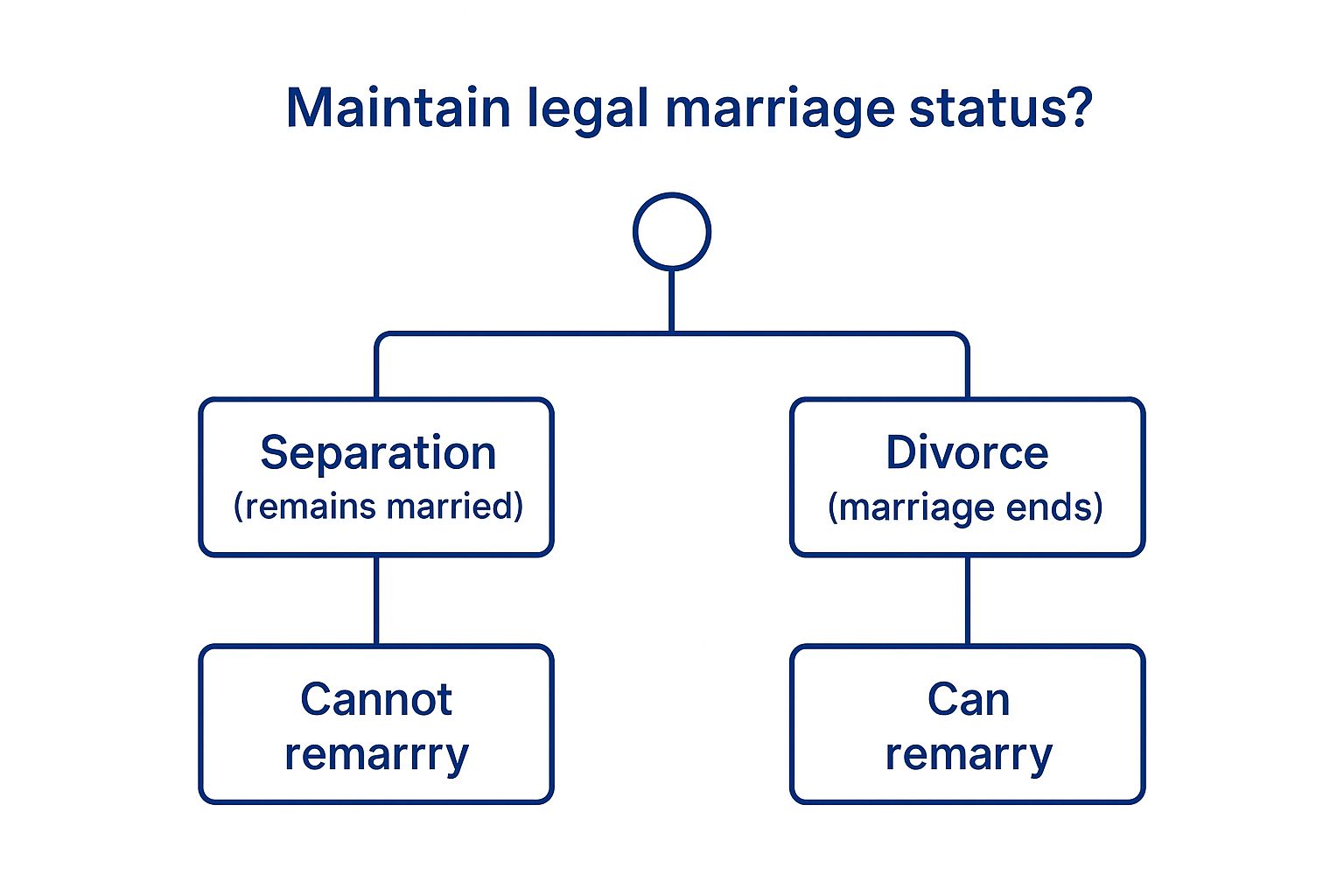Separation vs Divorce Under NY Family Laws: Key Differences Explained
Navigating the Maze: Separation vs. Divorce Made Easy
At Aronov Law NY, we find the shortcuts and loopholes in New York State law to simplify Family Law processes, including separation and divorce. We aim to make your legal experience smooth, efficient, and gratifying. This article clarifies the key differences between separation vs. divorce in New York, empowering you to navigate your legal journey with confidence. Understand how each impacts your legal status, finances, children, and potential for reconciliation, covering: legal status, financial implications, religious and cultural considerations, psychological impact, effects on children, legal process differences, and reconciliation possibilities.
Aronov Law NY prides itself on finding all the shortcuts and loopholes in New York State law to make any family law legal process as easy as the ABC’s. The information provided in this blog is designed to make your legal process smooth, efficient, easy, and gratifying. When facing the difficult decision of separation vs. divorce, understanding the legal distinctions is crucial. This article explores the key differences, starting with the most fundamental aspect: legal status.
1. Legal Status Distinction
The first and most critical difference between separation and divorce in New York lies in how the law defines your marital status. Legal separation means you and your spouse remain legally married but live apart, often with court orders dictating aspects like property division, spousal support, and child custody. Divorce, formally known as dissolution of marriage, completely severs the marital relationship, legally ending the marriage and allowing both parties to remarry. This core difference has cascading implications for your legal rights, responsibilities, and future options.
The infographic above visualizes the key decision points when considering separation vs. divorce. It starts with the question, “Do you wish to end the marriage legally?” and branches into the two paths: separation or divorce, outlining the resulting outcomes.
This decision tree helps illustrate the fundamental difference in legal status between separation and divorce. Choosing separation maintains the marriage, while divorce terminates it, each with specific implications for remarriage and legal responsibilities. Understanding this fundamental difference is the first step in navigating the complexities of family law in New York.
Features of Separation vs. Divorce in New York:
- Separation: Maintains the legal marriage bond. In New York, this can be achieved through a written separation agreement.
- Divorce: Legally ends the marriage contract entirely. New York is a “no-fault” divorce state, meaning you don’t need to prove grounds for divorce beyond an irretrievable breakdown of the marriage for at least six months.
- Both: Can involve court-ordered arrangements for children (custody, visitation, child support) and finances (spousal support, property division).
Pros and Cons:
Separation:
- Pros: Allows couples time and space apart while retaining certain legal benefits of marriage (e.g., health insurance). It can be a stepping stone to reconciliation or a less permanent alternative if religious beliefs prohibit divorce.
- Cons: Separated spouses in New York may still be legally responsible for certain joint debts and obligations. It can create ambiguity regarding legal rights and responsibilities, especially concerning property acquired during the separation.
Divorce:
- Pros: Provides a complete legal break, allowing for remarriage and a fresh start. Offers a definitive resolution to marital conflicts.
- Cons: Divorce has permanent legal consequences that are difficult to reverse. The process can be emotionally and financially taxing.
Examples in New York:
- Couples with significant shared financial interests, like a family business, might choose legal separation to restructure their affairs before considering divorce.
- Couples hesitant about the finality of divorce might opt for separation as a trial period or a way to address immediate issues while preserving the possibility of reconciliation.
Tips for Navigating Separation vs. Divorce in New York:
- Consult with a New York Family Law Attorney: State laws vary, and an attorney can advise you on the specifics of separation agreements and divorce proceedings in New York. Aronov Law NY specializes in these matters.
- Formalize Your Separation: A written separation agreement is essential in New York to clearly define the terms of the separation and protect your interests. The date of separation is critical for determining property division.
- Understand Debt Implications: Be aware of how New York law treats debt accrued during separation. A separation agreement should address responsibility for existing and future debts.
This first point about legal status is crucial because it lays the foundation for all subsequent decisions regarding your separation or divorce. Choosing between these two paths fundamentally impacts your legal standing, financial obligations, and future possibilities. Understanding this distinction is the first step towards making informed decisions about your future.
Aronov Law NY prides itself on finding all the shortcuts and loopholes in New York State law to make any legal process relating to Family law as easy as the ABC’s. The information provided in this blog is designed to make your legal process smooth, efficient, easy, and gratifying. When considering separation vs. divorce, understanding the nuances of each is crucial.
2. Financial Implications
Deciding between separation and divorce in New York carries significant financial implications that impact everything from taxes and healthcare to retirement accounts and debt liability. While separation may allow couples to maintain some of the financial benefits of marriage while establishing independent financial lives, divorce necessitates a complete and often complex financial disentanglement. Understanding these differences is crucial for making informed decisions.
Separation in New York: Legal separation requires a formal, written separation agreement outlining the division of assets, spousal support, child custody, and other financial responsibilities. While remaining legally married, the agreement allows for independent living and financial management. This can be beneficial in situations where a couple needs time to make final decisions or wishes to maintain certain benefits of marriage.
Divorce in New York: Divorce requires the complete legal termination of the marriage and necessitates a formal division of all assets, debts, and financial responsibilities. New York is an equitable distribution state, meaning assets are divided fairly, not necessarily equally. Factors considered include the length of the marriage, each spouse’s contributions, and their future needs.
Key Financial Considerations:
- Health Insurance: Separation may allow a spouse to maintain coverage under the other’s health insurance plan, a considerable advantage. Divorce, however, terminates this benefit, requiring each individual to secure their own coverage.
- Retirement Accounts and Pensions: Divorce in New York triggers the division of retirement accounts and pensions accrued during the marriage. Separation delays this process, potentially offering benefits for couples nearing retirement age.
- Tax Benefits: Filing jointly as a married couple often yields tax advantages. Separation can preserve these benefits, while divorce requires individuals to file separately.
- Debt and Asset Division: Both separation and divorce require decisions regarding the division of marital debts and assets. However, divorce mandates immediate action, which could force the liquidation of assets at unfavorable times. Separation allows for more strategic planning and timing.
Pros and Cons:
Separation Pros: Continued access to spouse’s health insurance, access to certain Social Security benefits, potential tax benefits of filing jointly, and time to plan for financial division.
Separation Cons: Continued liability for spouse’s debts in some situations, potential financial entanglement complications, and the need for a legally sound separation agreement.
Divorce Pros: Complete financial disentanglement and a fresh start.
Divorce Cons: Immediate division of assets, potential loss of health insurance benefits through a spouse, loss of joint tax benefits, and typically higher legal fees than separation.
Examples:
- A couple nearing retirement may opt for separation over divorce in New York to preserve Social Security benefits.
- Families with children in college might choose separation to maintain financial aid eligibility tied to marital status.
- Couples facing a serious illness might use separation to maintain insurance coverage while establishing personal boundaries.
Tips for Navigating the Financial Implications:
- Formal Separation Agreement: Create a detailed and legally sound separation agreement that addresses all financial aspects.
- Professional Advice: Consult with both a financial advisor and an experienced New York family law attorney like Aronov Law NY to understand your rights and options.
- Credit Management: Close joint credit accounts and establish individual credit during separation to avoid future financial entanglement.
- Tax Implications: Calculate the tax implications of both separation and divorce before making a decision.
Understanding the financial ramifications of separation versus divorce in New York is paramount. By carefully weighing the pros and cons and seeking professional advice, individuals can make informed choices that protect their financial future.
3. Religious and Cultural Considerations
At Aronov Law NY, we pride ourselves on navigating the complexities of New York State law, finding the shortcuts and loopholes to make your family law process as easy as ABC. The information in this blog is designed to streamline your legal journey, making it smooth, efficient, easy, and gratifying. When considering separation vs. divorce, religious and cultural factors often play a significant role, adding another layer of complexity to an already difficult decision. This section explores the impact of these considerations on your choices under New York law.
For many couples, religious and cultural beliefs are deeply intertwined with their understanding of marriage and its dissolution. This is especially true when deciding between separation vs. divorce. Many religious traditions have specific teachings about marriage dissolution. Some prohibit divorce entirely while accepting separation, creating tension between religious obligations and the legal solutions available for marital problems under New York State law. This tension can be particularly challenging when trying to navigate the legal landscape of separation vs. divorce.
Features of Religious and Cultural Influence:
- Specific Doctrines: Many religions have specific doctrines regarding divorce, influencing how couples approach legal separation vs. divorce.
- Compromise: Separation may offer a compromise between religious beliefs and practical needs, particularly when divorce is not religiously sanctioned but a legal separation offers necessary boundaries.
- Cultural Stigma: Cultural stigma may differ between separation and divorce, impacting the social and familial repercussions of each choice.
- Support Systems: Religious communities often provide different support systems for separated versus divorced members. Understanding these differences within your community can be helpful when considering separation vs. divorce.
Pros of Considering Religious and Cultural Factors in Separation vs. Divorce:
- Honoring Commitments: Separation can honor religious commitments while creating necessary personal and legal boundaries.
- Maintaining Faith Principles: Religious couples can maintain their faith principles while addressing marital breakdown by opting for legal separation initially.
- Cultural Acceptance: Cultural acceptance may be higher for separation in conservative communities, minimizing social pressures.
- Time for Reconciliation: Separation can provide time for religious counseling and reconciliation efforts before pursuing a final divorce under New York law.
Cons of Considering Religious and Cultural Factors in Separation vs. Divorce:
- Religious Limbo: Separation can create ongoing identity conflicts, especially when religious doctrines don’t clearly define the status of separated individuals. This can be further complicated by the specifics of New York State law regarding separation.
- Cultural Pressures: Cultural pressures may prevent establishing and maintaining healthy boundaries during separation, hindering personal growth and potentially complicating the legal process.
- Restrictions on Remarriage: Religious prohibitions against remarriage may limit future options, even after a legal divorce is finalized in New York.
- Community Judgment: Community judgment can add an emotional burden to either decision, regardless of the legal outcome in a separation vs. divorce case.
Examples:
- Catholic couples often pursue legal separation rather than divorce to remain in communion with the Church while also addressing the legal ramifications of their separation under New York State law.
- Orthodox Jewish couples may separate while working through religious divorce processes, navigating both religious and legal requirements simultaneously in New York.
- Conservative Muslim communities may recognize separation while religious scholars are consulted, adding a layer of complexity to the legal separation vs. divorce process in New York.
Tips for Navigating Religious and Cultural Considerations:
- Consult with Religious Leaders: Seek guidance from religious leaders alongside legal experts to understand the interplay between religious principles and New York State law.
- Seek Specialized Counseling: Find counseling from professionals who understand your religious framework and can offer support tailored to your specific needs.
- Join Support Groups: Connect with support groups within your faith tradition for shared experiences and guidance in navigating separation vs. divorce.
- Consider Community Impact: Reflect on how either choice (separation vs. divorce) affects your religious practices and community relationships within the framework of New York State Law.
Influential Figures and Organizations:
- Pope Francis: His reforms of Catholic annulment processes have impacted how Catholic couples navigate separation and divorce worldwide.
- Focus on the Family: This organization provides religious family counseling services that often address separation and divorce within a faith-based context.
- Faith-based Marriage Retreats: Many faith-based marriage retreats offer support and guidance to separated couples seeking reconciliation.
This consideration deserves a place on this list because religious and cultural beliefs are fundamental to many individuals’ identities and influence their decision-making processes, especially when facing complex choices like separation vs. divorce under New York State law. Understanding these influences is crucial for making informed decisions that respect both personal beliefs and legal realities. At Aronov Law NY, we can help you navigate these challenging intersections.
Aronov Law NY prides itself on finding all the shortcuts and loopholes in New York State law to make any legal process relating to Family law as easy as the ABC’s. The information provided in this blog is designed to make your legal process smooth, efficient, easy, and gratifying. Understanding the nuances of separation vs divorce is crucial for navigating this complex landscape.
4. Psychological Impact and Recovery Process
When considering separation vs divorce, the psychological impact and recovery process are paramount. This aspect significantly influences individual well-being and the ability to move forward constructively. The psychological experience of separation versus divorce differs significantly in terms of closure, identity adjustment, and emotional processing. Separation often creates an ambiguous loss with unclear boundaries, a sense of limbo that can stall emotional processing and prolong uncertainty. Divorce, conversely, represents a definitive end. While painful, this finality allows for clearer emotional processing and the opportunity to reconstruct one’s identity.
Both separation and divorce necessitate identity renegotiation and changes in social roles. However, the recovery timeline and stages differ. Temporary separation can create a holding pattern emotionally, while permanent divorce, despite its initial intensity, can often facilitate a quicker path towards emotional resolution. This isn’t to say that divorce is easy, but the clear boundaries can be a catalyst for healing.
Features of Separation and Divorce:
- Separation: Creates a state of limbo that can complicate grief processing; can provide space for personal growth while maintaining a connection; allows gradual adjustment to potential loss.
- Divorce: Provides clearer closure but may accelerate emotional confrontation; initiates healthy independence development; finality can be a catalyst for rebuilding.
Pros and Cons:
| Feature | Separation Pros | Separation Cons | Divorce Pros | Divorce Cons |
|---|---|---|---|---|
| Closure & Adjustment | Gradual adjustment | Prolonged uncertainty and anxiety | Definitive closure, facilitates moving forward | Intense grief responses |
| Emotional Impact | Space for personal growth, maintaining connection | Ambiguity complicates grief | Clearer emotional processing | Finality can be overwhelming |
| Children | Potential for reconciliation | Continued instability if unresolved | Stability through defined boundaries | Potential for increased parental conflict during proceedings |
Examples:
- Successful Reconciliation: Trial separations, guided by therapy, can lead to successful reconciliation and strengthened relationships.
- Healthy Co-parenting: Amicable divorces with clear boundaries often facilitate healthy co-parenting arrangements, minimizing the impact on children.
- Unresolved Separation: Long-term separations without clear goals can become emotionally complicated and detrimental to all involved.
Tips for Navigating the Psychological Impact:
- Establish Clear Boundaries: Whether separating or divorcing, define clear expectations and boundaries regarding finances, living arrangements, and communication. This clarity reduces ambiguity and provides a framework for moving forward.
- Seek Therapeutic Support: Individual therapy is invaluable, regardless of whether you choose separation or divorce. A therapist can provide guidance through the emotional challenges and help develop coping mechanisms.
- Support Groups: Joining support groups specific to your situation (separation or divorce) can provide a sense of community and shared experience, reducing feelings of isolation.
- Self-Care: Prioritize self-care practices like exercise, mindfulness, and healthy eating to manage stress during these challenging transitions.
- Consider Children’s Needs: Acknowledge the potential psychological impact on children and seek appropriate support, such as child therapy or family counseling.
Influential Voices:
The field of relationship dynamics has provided valuable insights into navigating separation and divorce. Therapists like Katherine Woodward Thomas, known for her work on “Conscious Uncoupling,” offer approaches for navigating separation and divorce with greater awareness and compassion. Divorce recovery programs like DivorceCare provide structured support and resources. The work of psychologists specializing in ambiguous loss, such as Pauline Boss, sheds light on the complexities of separation and its psychological implications.
This aspect of separation vs divorce deserves careful consideration as emotional well-being significantly influences your ability to navigate legal proceedings and rebuild your life. By understanding the potential psychological impacts and proactively seeking support, you can navigate these challenging transitions with greater resilience and create a healthier future for yourself and your family. At Aronov Law NY, we understand these challenges and are here to support you through every step of the legal process.
5. Impact on Children
At Aronov Law NY, we pride ourselves on navigating the complexities of New York State law to make family law processes as straightforward as possible. We understand that legal matters, especially those involving children, can be stressful. Our goal is to make your experience smooth, efficient, easy, and ultimately gratifying. The information provided in this blog is designed to equip you with the knowledge you need to navigate these challenges. When considering separation vs. divorce, the impact on your children is paramount. This section addresses this crucial aspect.
Understanding how separation vs. divorce affects children is crucial for any parent navigating these difficult transitions. While both disrupt a child’s world, they present distinct challenges regarding stability, comprehension, and adjustment. The way parents handle the process, regardless of whether it’s a separation or a divorce, holds significantly more weight than the legal status itself. This section explores the nuances of this impact and offers guidance for prioritizing your children’s well-being during this time.
How Separation vs. Divorce Impacts Children:
Separation, while potentially temporary, can create confusion for children about the permanence of the family changes. They may hold onto hope for reconciliation, leading to anxiety and attachment issues if the separation ultimately leads to divorce. Younger children may struggle to grasp the concept of separation, requiring age-appropriate explanations and reassurance.
Divorce, being a permanent legal dissolution of the marriage, requires a more explicit and definitive explanation for children. While it provides clarity, the finality of divorce can trigger feelings of abandonment and loss, particularly in younger children. Older children and adolescents may grapple with complex emotions surrounding loyalty, blame, and the changing family dynamic.
Features of each regarding children:
- Separation: Uncertainty surrounding the future of the family. Potential for ongoing parental conflict if the terms of separation are not clearly defined.
- Divorce: Requires clear communication about the permanence of the change. Necessitates establishing new, stable routines and co-parenting arrangements.
Pros & Cons:
| Feature | Separation Pros | Separation Cons | Divorce Pros | Divorce Cons |
|---|---|---|---|---|
| Impact on Children | Gradual adjustment to changes | Uncertainty and anxiety | Clarity and stable new routines | Permanence can trigger abandonment fears |
| Parental Relationship | Opportunity for reconciliation | Potential for ongoing conflict | Clear boundaries and expectations | Potential for increased conflict during proceedings |
| Legal Status | Less formal, more flexible | May lack legal protections | Legally binding agreements | More complex and potentially costly |
Examples of successful implementation:
- Bird-nesting arrangements during separation: Children remain in the family home, and parents rotate in and out, providing stability and minimizing disruption to the children’s environment. This approach minimizes change for children while parents navigate the separation.
- Successful co-parenting schedules after divorce: Parents establish and adhere to consistent co-parenting schedules that prioritize the children’s needs and provide predictability. This can involve shared physical custody, well-defined visitation schedules, and consistent communication between parents.
- Family therapy: Seeking professional guidance from family therapists specializing in separation and divorce can equip families with coping strategies and communication tools to navigate the challenges. Therapists can help children process their emotions and adjust to the new family dynamic, while also guiding parents in effective co-parenting.
Tips for Parents:
- Maintain consistent routines: Keep children’s daily schedules, including school, extracurricular activities, and bedtime routines, as consistent as possible.
- Open Communication: Talk openly with your children in an age-appropriate way. Explain the difference between separation and divorce clearly and reassure them of your continued love and support.
- Avoid involving children in adult decisions: Do not put children in the middle of disagreements or use them as messengers between parents.
- Seek professional support: Consider age-appropriate counseling for children and family therapy to address specific concerns and develop coping strategies.
- Consistent co-parenting communication: Establish clear and respectful communication channels between parents to address issues related to the children’s well-being and co-parenting arrangements.
The impact of separation vs. divorce on children is a critical consideration. Research from experts like developmental psychologist Judith Wallerstein and parenting experts like Christina McGhee highlights the long-term effects of these transitions on children’s well-being. By prioritizing your children’s needs, maintaining open communication, and seeking professional guidance, you can navigate these challenges and support your children through this significant life change.
6. Legal Process Differences
At Aronov Law NY, we pride ourselves on navigating the complexities of family law and finding the most efficient path for our clients. We understand the emotional and legal challenges involved in separation and divorce, and our goal is to make the process as smooth, efficient, easy, and gratifying as possible. The information provided in this blog is designed to simplify your legal journey and empower you with the knowledge you need.
When considering separation vs. divorce, understanding the legal process differences is crucial. These differences significantly impact complexity, timeline, and requirements, especially in New York. While both involve legal procedures, they have distinct characteristics. This section clarifies those distinctions to help you make informed decisions.
Legal separation in New York requires formal court filings and a legally binding separation agreement. This agreement outlines issues like child custody, spousal support, and asset division, much like a divorce agreement. While providing legal structure to the separation, it does not terminate the marriage. Divorce, on the other hand, legally dissolves the marriage. New York allows both “at-fault” and “no-fault” divorce. “No-fault” divorce, which only requires showing an irretrievable breakdown of the marriage for at least six months, has become the most common.
Features:
- Separation: Requires a formal written separation agreement. This agreement must be filed with the court to be legally enforceable.
- Divorce: Requires specific grounds (reasons) or a waiting period after a separation agreement.
- Both Processes: Involve documentation of assets, debts, income, and arrangements for children.
Pros:
- Separation: Allows couples time to resolve issues and potentially reconcile. It can also address immediate needs for financial support and custody arrangements.
- Divorce: Provides complete legal finality, allowing individuals to remarry.
- Both Processes: Establish clear legal rights and responsibilities.
Cons:
- Divorce: May require a longer process than obtaining a separation agreement.
- Going through Separation then Divorce: Involves two separate legal processes and therefore increased costs and time.
- Both: Can involve significant legal complexity, though separation agreements tend to be less complex than contested divorces.
Examples:
- Couples signing a separation agreement addressing custody and support, later converting it into a divorce agreement.
- Contested divorce proceedings requiring extensive litigation due to disagreements over property division.
- Mediated separation agreements that avoid adversarial court proceedings.
Tips:
- Research New York’s specific requirements: Divorce and separation laws vary significantly by state. Focus your research on New York law.
- Consider mediation or collaborative law: These methods can reduce conflict and costs in both separation and divorce.
- Organize financial documentation: Gather all relevant information about assets, debts, and income before initiating the process. This will expedite things significantly.
- Understand the conversion process from separation to divorce in New York: If you choose legal separation, ensure you know the steps required to convert it to a divorce later if needed.
Dealing with legal processes like separation and divorce can be particularly challenging when combined with other life events, such as the death of a spouse. During these difficult times, understanding legal procedures becomes even more important. For example, if a spouse dies without a will, their assets are distributed according to state intestacy laws. For further information on this process, particularly in California, you can consult resources on intestate estates.
Why This Item Deserves Its Place on the List:
Understanding the legal procedures is paramount when deciding between separation and divorce. This section empowers individuals to make informed decisions about their future by clarifying the distinct processes, requirements, and potential implications of each path. At Aronov Law NY, we help clients navigate these intricacies, providing expert guidance and support throughout the process.
7. Reconciliation Possibilities
At Aronov Law NY, we pride ourselves on navigating the complexities of New York State law to simplify your family law matters. We strive to make the legal process as easy as ABC, providing you with a smooth, efficient, and gratifying experience. The information in this blog is designed to empower you with knowledge and make your journey through these challenging times easier. One crucial point to consider when facing marital difficulties is the potential for reconciliation, a key differentiator between separation vs divorce.
Reconciliation, the possibility of rekindling a marriage, represents a pivotal distinction between separation and divorce under New York State law. Separation, especially when structured as a trial separation, offers the opportunity for reflection, growth, and potential reunion while still maintaining the legal bonds of marriage. Divorce, conversely, signifies legal finality, making reconciliation a more complex endeavor that requires remarriage to restore the legal relationship.
How Reconciliation Works Within Separation and Divorce:
- Separation: Because separation maintains the legal framework of marriage, reconciliation is inherently simpler. Couples can reconcile at any point without needing to remarry. A trial separation can be explicitly designed with reconciliation as a primary goal, outlining specific steps and milestones to achieve this.
- Divorce: Once a divorce is finalized in New York, the legal marriage is dissolved. If a couple wishes to reunite after divorce, they must remarry, effectively creating a new legal marriage. This often requires navigating legal procedures similar to the initial marriage process.
Examples:
- A couple in New York engages in a therapeutic separation, attending regular counseling sessions with a focus on improving communication and resolving conflict. They successfully reconcile after six months and continue their marriage.
- A divorced couple, after years of personal growth and reflection, realize they want to rekindle their relationship. They remarry under New York State law, establishing a new legal marriage.
- A separation agreement in New York incorporates provisions for reconciliation, outlining expectations, responsibilities, and timelines for evaluating the progress towards reuniting.
Pros and Cons:
| Feature | Pros | Cons |
|---|---|---|
| Separation | Provides breathing room while maintaining legal commitments. | Can extend unhealthy dynamics without clear goals. |
| Structured separation can include reconciliation milestones. | Hope for reconciliation can hinder necessary personal adjustment. | |
| Divorce | Creates a clear legal break. | Creates legal barriers to reconciliation (requires remarriage). |
| Both | Can end destructive patterns hindering healthy connection. | Both processes can develop momentum that makes reconciliation harder. |
Tips for Navigating Reconciliation:
- Establish Clear Goals and Timelines: Define specific, measurable, achievable, relevant, and time-bound (SMART) goals for a trial separation. This provides structure and accountability.
- Consider Therapeutic Separation: Professional guidance from a therapist or counselor can facilitate productive communication and conflict resolution.
- Maintain Appropriate Boundaries: Even during separation, establishing healthy boundaries regarding finances, living arrangements, and communication is essential.
- Develop Individual Self-Awareness: Regardless of the outcome, focus on personal growth and self-reflection to understand your role in the relationship dynamics.
- Create Structured Communication: Implement regular check-ins and communication protocols during separation to avoid misunderstandings and address issues effectively.
- Consider Post-Divorce Counseling: If considering remarriage after divorce, premarital counseling can help address past issues and build a stronger foundation for the new marriage.
Why Reconciliation Deserves its Place on this List:
The potential for reconciliation is a critical factor to consider when choosing between separation and divorce. Understanding the implications of each path concerning reconciliation empowers couples to make informed decisions aligned with their long-term goals. While some couples find that a definitive break is necessary, others may benefit from the space and structure that separation provides for potential reconciliation. This consideration is particularly important in New York, where the legal ramifications of separation and divorce are distinct.
Separation vs Divorce: 7 Key Aspect Comparison
| Concept | Implementation Complexity 🔄 | Resource Requirements ⚡ | Expected Outcomes 📊 | Ideal Use Cases 💡 | Key Advantages ⭐ |
|---|---|---|---|---|---|
| Legal Status Distinction | Moderate; requires formal filings for separation or divorce | Legal counsel and court involvement | Separation maintains marriage legally; Divorce ends marriage completely | Couples needing temporary separation or complete legal end | Separation maintains benefits; Divorce allows remarriage |
| Financial Implications | Moderate to High; complex asset & debt division | Legal and financial advisors, planning | Separation may preserve insurance & tax benefits; Divorce requires asset division | Couples wanting to preserve benefits or plan financial disentanglement | Separation maintains financial benefits temporarily |
| Religious and Cultural Considerations | Variable; depends on religious and cultural rules | Religious leaders, counselors | Separation may align with religious prohibitions on divorce; Divorce ends marriage | Couples balancing faith and marital decisions | Separation honors religious beliefs; provides reconciliation space |
| Psychological Impact and Recovery Process | Moderate; involves emotional and identity adjustments | Therapists, support groups | Separation causes ambiguity; Divorce provides closure | Individuals needing gradual adjustment or clear closure | Separation offers adjustment time; Divorce facilitates closure |
| Impact on Children | Moderate; requires thoughtful communication and co-parenting | Counselors, parenting resources | Separation may cause uncertainty; Divorce provides clarity with stable routines | Parents prioritizing children’s stability | Both can reduce conflict; Promote healthy boundaries for children |
| Legal Process Differences | High; involves court procedures & legal documentation | Legal counsel and court systems | Separation legally recognized but marriage intact; Divorce finalizes marriage | Those needing formal separation or complete dissolution | Separation can be faster; Divorce provides finality |
| Reconciliation Possibilities | Moderate; requires clear goals and structured process | Therapists, mediation | Separation allows easier reconciliation; Divorce legally final, needs remarriage | Couples exploring potential reunion | Separation maintains legal ties; Facilitates reflection time |
Making the Right Choice for Your Future
Choosing between separation vs divorce is a deeply personal decision with significant legal, financial, and emotional ramifications. This article has explored the key distinctions between these two paths, from their varying legal statuses and financial implications under New York State Law to their impact on children and the potential for reconciliation. We’ve also touched upon the religious and cultural considerations that may influence your choice, as well as the psychological toll and recovery process associated with each. Mastering these concepts empowers you to navigate this challenging period with greater clarity and make informed decisions that align with your long-term goals.
At Aronov Law NY, we pride ourselves on finding all the shortcuts and loopholes within New York State Law to make any family law process, including separation and divorce, as easy as the ABC’s. The information provided here is designed to make your legal journey smooth, efficient, easy, and ultimately, gratifying. However, it’s crucial to remember that every situation is unique. Whether you’re grappling with child custody, prenuptial agreements, visitation rights, or the complexities of separation vs divorce, understanding your options under New York State Law is paramount.
Navigating the legal landscape of separation vs divorce in New York can be daunting. Aronov Law NY specializes in family law and can provide expert guidance tailored to your specific circumstances. Secure your future and gain clarity today with a free consultation at Aronov Law NY. We’re here to help you make informed decisions and achieve the best possible outcome.


Free Legal Consultation
98-14 Queens Blvd



